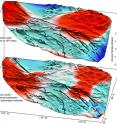New analysis reveals large-scale motion around San Andreas Fault System
An array of GPS instruments near the San Andreas Fault System in Southern California detects constant motion of Earth's crust--sometimes large, sudden motion during an earthquake and often subtle, creeping motion. By carefully analyzing the data recorded by the EarthScope Plate Boundary Observatory's GPS array researchers from the University of Hawai'i at Mānoa (UHM), University of Washington and Scripps Institution of Oceanography (SIO) discovered nearly 125 mile-wide "lobes" of uplift and subsidence--a few millimeters of motion each year--straddling the fault system. This large scale motion was previously predicted in models but until now had not been documented. The GPS array records vertical and horizontal motion of Earth's surface. Vertical motion is affected by many factors including tectonic motion of the crust, pumping of groundwater, local surface geology, and precipitation. The challenge faced by Samuel Howell, doctoral candidate at the UHM School of Ocean and Earth Science and Technology (SOEST) and lead author of the study, and co-authors was to discern the broad, regional tectonic motion from the shorter-scale, local motion.
To tease out such motions, the team used a comprehensive statistical technique to extract from the GPS data a pattern of large-scale, smoothly varying vertical motions of the local crust.
"While the San Andreas GPS data has been publicly available for more than a decade, the vertical component of the measurements had largely been ignored in tectonic investigations because of difficulties in interpreting the noisy data. Using this technique, we were able to break down the noisy signals to isolate a simple vertical motion pattern that curiously straddled the San Andreas fault," said Howell.
The pattern resulting from their data analysis was similar in magnitude and direction to motions predicted by previously published earthquake cycle model results led by co-authors Bridget Smith-Konter, associate professor at UHM SOEST, and David Sandwell, professor at SIO.
"We were surprised and thrilled when this statistical method produced a coherent velocity field similar to the one predicted by our physical earthquake cycle models," said Smith-Konter. "The powerful combination of a priori model predictions and a unique analysis of vertical GPS data led us to confirm that the buildup of century-long earthquake cycle forces within the crust are a dominant source of the observed vertical motion signal."
The new findings, published today in Nature Geoscience, indicate that researchers can use GPS vertical motion measurements to better understand the structure and behavior of faults, even in times of earthquake quiescence, when no major ruptures have occurred for several decades to centuries. As scientists patiently monitor the San Andreas Fault System for indications of the next big earthquake, these results will help constrain seismic hazard estimates and may allow for a more prudent mapping of the large-scale motion resulting from the next significant rupture of the San Andreas.
Source: University of Hawaii at Manoa
Other sources
- San Andreas Fault 'Does the Wave,' New Research Findsfrom Live ScienceThu, 23 Jun 2016, 14:51:07 UTC
- New analysis reveals large-scale motion around San Andreas Fault Systemfrom Science DailyTue, 21 Jun 2016, 14:31:21 UTC
- Large-scale motion detected near San Andreas Fault Systemfrom UPIMon, 20 Jun 2016, 18:31:02 UTC
- New Analysis Reveals Large-Scale Motion Around San Andreas Fault Systemfrom Newswise - ScinewsMon, 20 Jun 2016, 17:51:08 UTC
- New analysis reveals large-scale motion around San Andreas Fault Systemfrom PhysorgMon, 20 Jun 2016, 15:01:15 UTC

